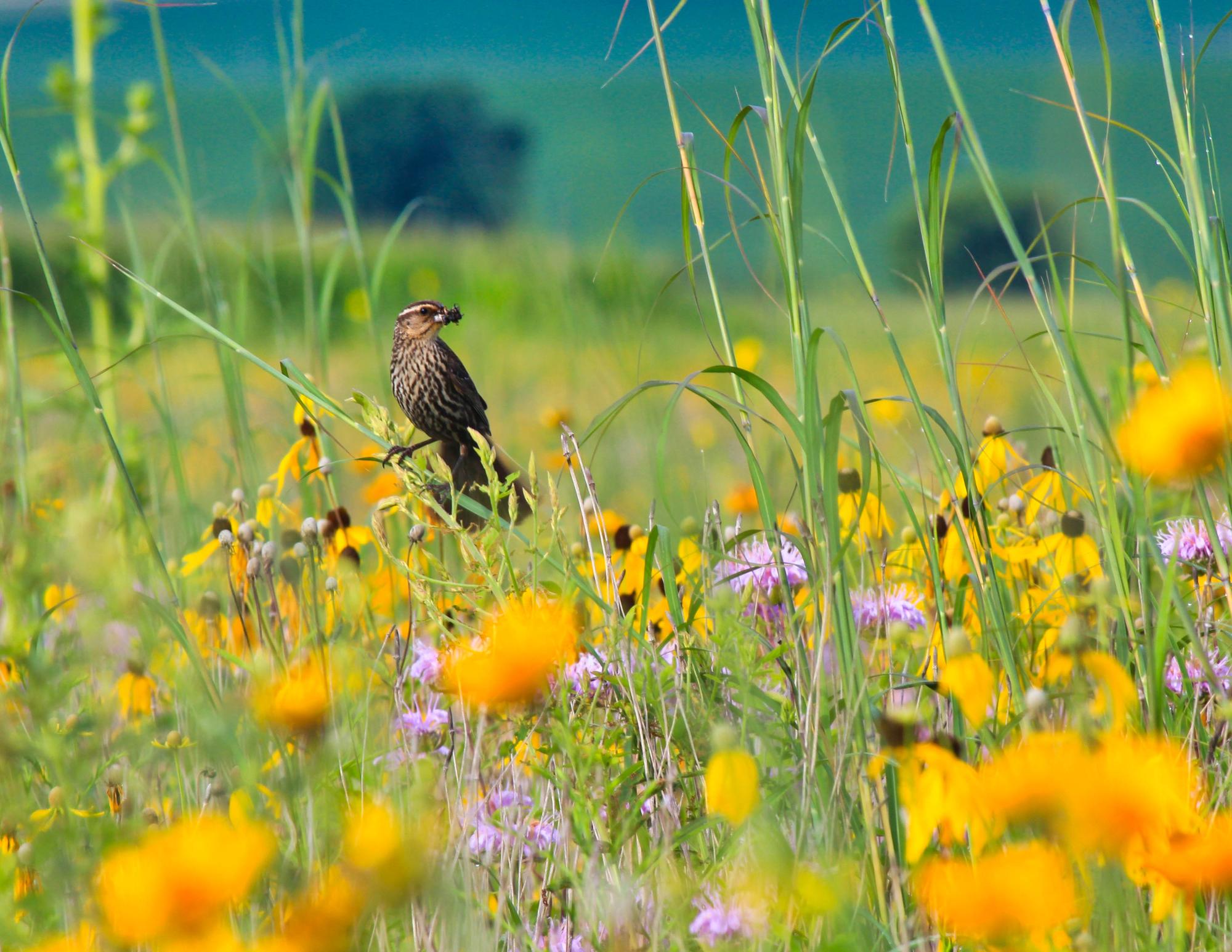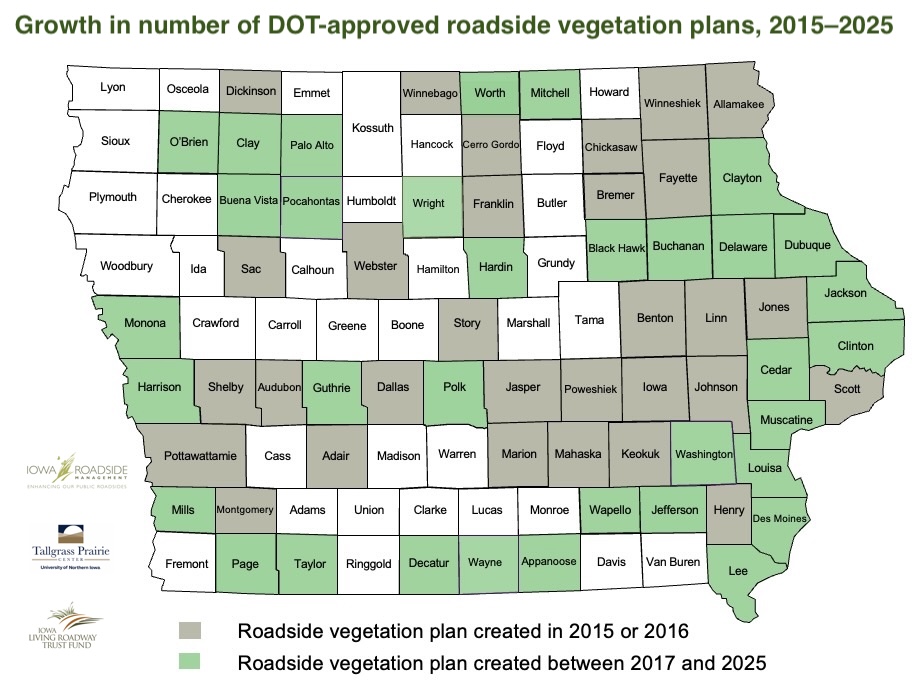Frequently Asked Questions

Safety
- How do tall prairie plants in the roadside impact driver vision and safety?
When it comes to integrated roadside vegetation management, safety is always the first priority. To make sure drivers have an unobstructed view, tall prairie vegetation should not be planted in the clear zone, or the area of the roadside closest to the pavement.
Studies indicate that drivers are drowsier when roadside scenery is monotonous. Roadsides with many different types of plants may result in increased driver alertness and reduced crash rates, although more research is needed regarding these outcomes. The seed mixes provided by Iowa Roadside Management contain 20–38 plant species, creating a vibrant and varied roadside. The tall prairie vegetation may also provide a softer landing and slowing effect for vehicles that go off the road.
- How do reduced mowing and native plants in the roadside impact roadway hazards like deer?
Because deer prefer to eat young, green grasses that have been freshly mowed, reduced mowing can reduce the appeal of roadside vegetation. However, studies in Florida and North Dakota have found that reduced mowing had no effect on deer-vehicle and other wildlife-vehicle collisions. The factors affecting deer-vehicle collisions are complex. But in Midwestern areas with a lot of agriculture, variations in traffic volume and the abundance of deer may be better predictors of deer-vehicle collisions than landscape composition, although there also appear to be a lot of deer near wooded areas.
Additionally, reduced mowing reduces the likelihood of debris being unintentionally flung from mowers into the road and traffic.
Erosion
- How do prairie plants in the roadside help reduce erosion?
Warm-season grasses that are included in prairie seed mixes for roadsides include big bluestem, Indiangrass, and switchgrass; these grasses and some wildflowers have dense roots that are up to 6-9 feet deep. These dense roots make them especially suitable for reducing soil erosion, in comparison to shallow-rooted cool-season grasses such as tall fescue, with roots up to 2-3 feet deep. Many engineers and roadside managers have found prairie plants reduce erosion and site erosion control well. Research on prairie strips planted within farmland has found prairie grasses to be effective in reducing erosion.
Some people think seed mixes with warm-season grasses are too complicated to plant and take too long to establish. However, a stand of native grasses and wildflowers can be established successfully without increased erosion if proper seeding depth is used when planting, weeds are effectively controlled with herbicides and mowing during the first year to reduce weed competition, and quickly establishing cover or nurse crops, such as oats, are planted with the seed mix.
- Since it takes prairie plants three years to mature, won't a lot of erosion on steep roadside slopes occur in the meantime?
Roadside managers typically include a fast-growing cover crop such as rye, oats, or winter wheat when planting prairie plants in the roadside. Rye, oats, and wheat cover the ground and reduce erosion while the slower-growing prairie plants are establishing. The prairie seed mixes include some species that establish more quickly than other prairie plants, like Canada wild rye and black-eyed susan. Many roadsides are hydroseeded with a mulch that also contributes to providing erosion control.
Landowners and Residents
- Will native plants spread from the roadside into adjacent farmland?
Iowa State's STRIPS team has planted strips of prairie directly within cropland for farmers who are interested in soil conservation, improved water quality, and habitat. The researchers have found that prairie plants do not spread well into tilled or conventionally sprayed farmland.
- Do prairie plants plug tile lines?
Video footage taken by Iowa State and the Tallgrass Prairie Center of different farms has shown few if any prairie roots infiltrating tile lines and certainly not obstructing tile lines. Tiles in low-lying areas may become plugged by reed canarygrass, an aggressive non-native plant that is never included in prairie seed mixes.
- Why is my county or city removing trees and shrubs from the road right-of-way?
Many residents understandably value trees and shrubs that provide good wildlife habitat and serve as a wind break. However, woody vegetation that is too large and close to the road poses a safety hazard for vehicles that enter the roadside. According to the Federal Highway Administration, trees larger than four inches in diameter are safety issues for errant vehicles. Trees near sites that are often the scene of accidents, such as curves and intersections, may also need to be removed. Sometimes trees and shrubs are removed from roadside prairie plantings to prevent the woody species from shading out the prairie plants; many prairie species require full sunlight to grow. For more information, check out our handout on Brush-Cutting in County Roadsides: Safety and Utility.
- How do prairie plants in the roadside improve water quality?
With their dense roots, prairie plants act like a sponge to effectively filter and remove pollutants. The dense roots also mean prairie plants are more effective competitors against weeds than cool-season grasses, such as fescue and smooth brome; fewer weeds means less herbicides need to be used for weed control. For more information about prairie roots, click here.
- How does planting prairie plants in roadsides help bees and butterflies? Aren't they just killed by vehicles anyway?
Native prairie roadside grasses and wildflowers provide important sources of food and shelter for bees and butterflies. Studies suggest that in roadsides with less frequent mowing and more types of prairie plants, butterflies are less likely to cross the road and be killed, possibly because they don't have to cross the road to search for more habitat. Research also suggests the relative proportion of the local pollinator population killed by vehicles is relatively small and there is a net benefit to having habitat available in the roadside. Collisions may increase during fall migration for monarch butterflies and in areas with high traffic counts. For more information, see the Xerces Society's website on pollinators and roadsides and Monarch Joint Venture's frequently asked questions about monarchs and roadsides.
- Does my county have a roadside manager? How do I learn more about encouraging them to start a roadside program and hire a roadside manager?
Check this map to see if your county has a roadside manager. If the engineer is listed as the main roadside vegetation contact for your county, the county likely doesn't have a separate roadside manager on staff. The second chapter of the Integrated Roadside Vegetation Technical Manual, Steps to Start a Roadside Vegetation Program, explains how to start and implement a program.
Contact Kristine Nemec at the UNI Tallgrass Prairie Center (kristine.nemec@uni.edu, 319-273-2813) with questions about starting a county program or Tara Van Waus at the Iowa DOT (tara.vanwaus@iowadot.us, 515-460-2953) with questions about starting a city program or developing an IRVM plan for counties or cities.
Government
- How does reduced mowing save money?
Mowing is needed to keep the vegetation short in some areas of the roadside, such as the part closest to the road pavement, intersections, and driveways so drivers have good sightlines. However, in other areas of the roadside further from the road, frequent mowing for safety purposes is less necessary. Over the last 15 years, more state DOTs have been cutting back on mowing to save money and establish pollinator habitat; counties and cities can also experience savings from reduced mowing. Replacing one acre of cool-season grasses such as Kentucky bluegrass, fescue, or smooth brome with prairie will be more expensive than just mowing these grasses the year that the prairie is planted. However, once the prairie plants establish, they do not need to be mowed as often as cool-season grasses, which saves money on fuel, equipment, and labor.
This handout uses information from the City of Cedar Falls mowing research to demonstrate cost savings by replacing one acre of turf with prairie over five years. Although the handout is not specific to roadsides and the exact costs may vary by county or city, it captures the resources needed to establish prairie and how cost savings through reduced mowing can be realized over time. Unlike the example in the handout, while counties and cities with an IRVM plan need to provide the labor, mulch, and equipment to plant prairie in the roadside, they can receive roadside prairie seed for free (a value of $220-$375/acre through a large seed purchase from the Tallgrass Prairie Center) and apply for grants from the Living Roadway Trust Fund to partially cover the costs of the equipment.
With their dense roots, prairie plants act like a sponge to effectively filter and remove pollutants. The dense roots also mean prairie plants are more effective competitors against weeds than cool season grasses such as fescue and smooth brome; fewer weeds means less herbicides need to be used for weed control. For more information about prairie roots, click here.
- How does having a roadside manager help a county or city be more efficient and manage for safe, healthy roadsides?
A roadside manager provides leadership and efficient use of government resources by:
- Being the one-stop shop, the go-to person who is familiar with a county or city's roadside vegetation; using their knowledge, they proactively prioritize smart ways to manage weeds and brush, mow, and plant and manage native plantings that are cost-effective and reduce environmental impacts
- Saving money with strategic mowing and herbicide use
- Saving money by applying for free native prairie seed from the Tallgrass Prairie Center and grants from the Living Roadway Trust Fund to help cover the costs of roadside management equipment and roadside vegetation inventories
- Serving as a resource for residents who have questions about their own conservation and land management projects, for example knowing where to buy supplies such as erosion control products
- Being available to manage weeds and prairie plantings during windows of opportunity when weather conditions are best; especially on a county's many small roadside projects, contractors might not have the flexibility to show up quickly when conditions are right for managing a given weed, producing better results that don't have to be fixed later on
- Participating in two annual meetings and a Google group where the roadside manager community learns from each other and from experts about best management practices
- Which counties have a roadside vegetation plan approved by the Iowa Department of Transportation?
In 2015, the Iowa Department of Transportation revealed a new, more thorough template for integrated roadside vegetation management (IRVM, or roadside) plans. The below map shows which counties have a plan on file with the DOT using the latest DOT plan guidance.

- Which Iowa counties and cities received native seed this year to plant in their roadsides?
Only counties or cities that have an approved roadside plan (IRVM plan, or integrated roadside vegetation management plan) on file with the Iowa Department of Transportation can request free native seed for their road rights-of-way. The seed has a value of $200-$300/acre and is free to county and city governments with a plan since the UNI Roadside Office uses a grant to purchase the seed. Many counties request seed every year while some counties request seed every 2 to 3 years. In 2025, the below counties received seed. No cities requested seed.
Adair
Audubon
Benton
Black Hawk
Bremer
Buchanan
Buena Vista
Cedar
Cerro Gordo
Chickasaw
Clay
Clayton
Clinton
Dallas
Des Moines
Dickinson
Fayette
Franklin
Guthrie
Hardin
Iowa
Jackson
Jasper
Johnson
Jones
Keokuk
Lee
Linn
Mahaska
Marion
Mills
Mitchell
Muscatine
Palo Alto
Polk
Pottawattamie
Poweshiek
Sac
Scott
Shelby
Story
Wapello
Washington
Webster
Winneshiek
Worth
If you have any other questions, please contact Roadside Program Manager Kristine Nemec at kristine.nemec@uni.edu or 319-273-2813. She can answer your question or direct you to the right person or resource. Resources for the information on this page are available on request.


